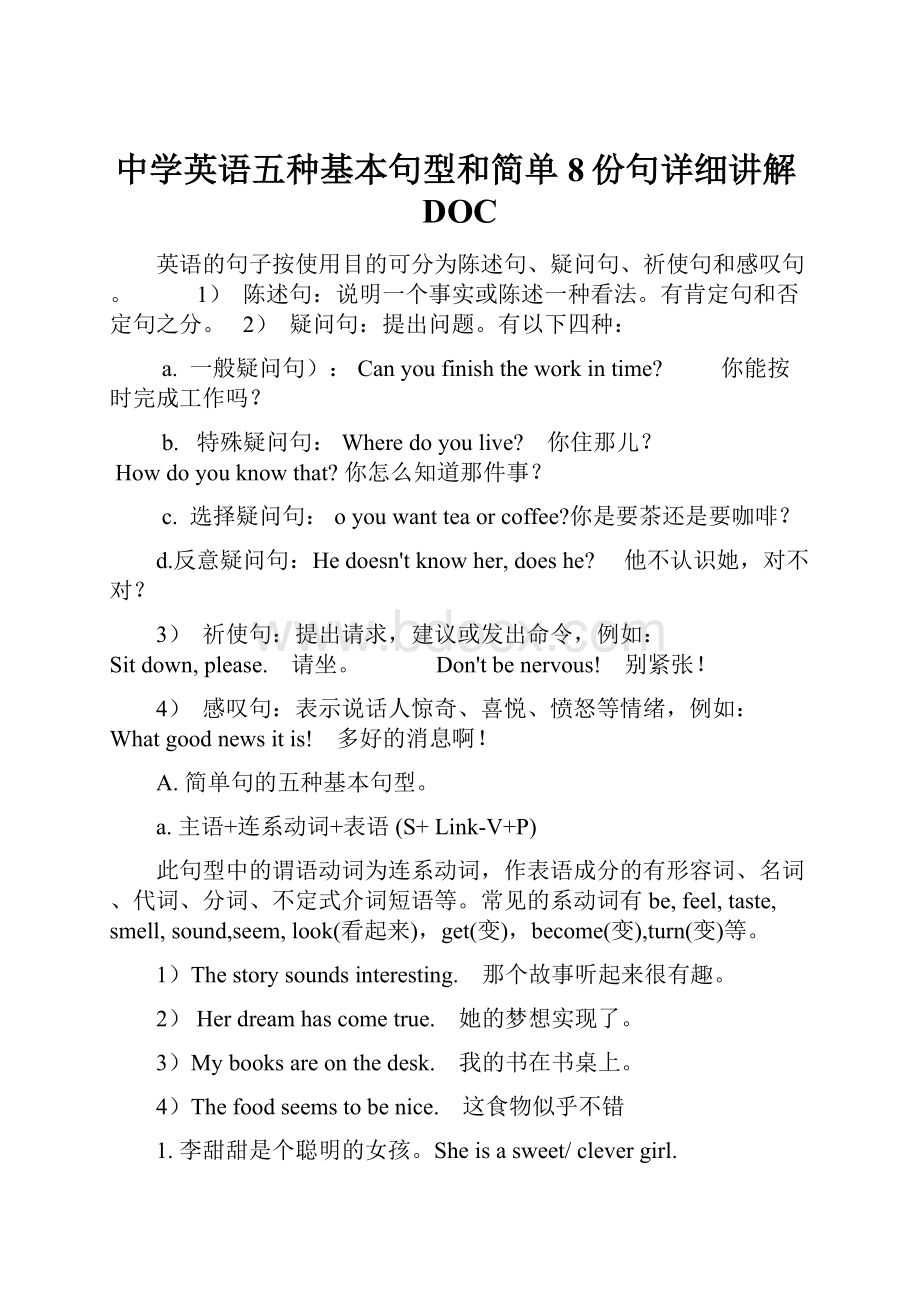中学英语五种基本句型和简单8份句详细讲解DOC.docx
《中学英语五种基本句型和简单8份句详细讲解DOC.docx》由会员分享,可在线阅读,更多相关《中学英语五种基本句型和简单8份句详细讲解DOC.docx(19页珍藏版)》请在冰豆网上搜索。

中学英语五种基本句型和简单8份句详细讲解DOC
英语的句子按使用目的可分为陈述句、疑问句、祈使句和感叹句。
1) 陈述句:
说明一个事实或陈述一种看法。
有肯定句和否定句之分。
2) 疑问句:
提出问题。
有以下四种:
a. 一般疑问句):
Can you finish the work in time?
你能按时完成工作吗?
b. 特殊疑问句:
Where do you live?
你住那儿?
How do you know that?
你怎么知道那件事?
c. 选择疑问句:
o you want tea or coffee?
你是要茶还是要咖啡?
d.反意疑问句:
He doesn't know her, does he?
他不认识她,对不对?
3) 祈使句:
提出请求,建议或发出命令,例如:
Sit down, please. 请坐。
Don't be nervous!
别紧张!
4) 感叹句:
表示说话人惊奇、喜悦、愤怒等情绪,例如:
What good news it is!
多好的消息啊!
A.简单句的五种基本句型。
a.主语+连系动词+表语(S+Link-V+P)
此句型中的谓语动词为连系动词,作表语成分的有形容词、名词、代词、分词、不定式介词短语等。
常见的系动词有be,feel,taste,smell,sound,seem,look(看起来),get(变),become(变),turn(变)等。
1)The story sounds interesting. 那个故事听起来很有趣。
2) Her dream has come true. 她的梦想实现了。
3)Mybooksareonthedesk.我的书在书桌上。
4)Thefoodseemstobenice.这食物似乎不错
1. 李甜甜是个聪明的女孩。
Sheisasweet/clevergirl.
2. 张飞在三年级六班。
ZhangFeiisinClassTwo,GradeThree.
3. 早起有益于身体健康。
Gettingupearly/earlyrisingishelpfulforourhealth.
4. 这些玫瑰花闻起来很香。
Thesesmellsfragrant/nice.
b.主语+不及物动词(S+V)
在此句型中,谓语动词是不及物动词,其后没有宾语。
因为此句型中的动词表达的意思已经很明确,所以不需要跟宾语。
有时为了表示动作发生的频率、程度、原因、结果、目的、场所、时间等,可以带状语修饰动词。
如:
1)Myheadaches.我头疼。
2)Thestudentsarelistening.学生们正在听。
3)We study hard. 我们努力学习。
4) The red sun rises in the east. 一轮红日从东方升起。
5) The Second World War broke out in 1939. 1939年爆发了第二次世界大战。
6) The boy looked out of the window. 那个男孩朝窗外看去。
主语和不及物动词(短语)是组成本句型不可缺少的必要成分。
在实际运用中,不及物动词往往与副词、介词及其它相关成分有相对稳定的搭配关系。
1.我们的英语老师教得很好。
2.五年前宋杰住在合肥。
3.一天,她欢快地走进我的房间。
4. 你们打算乘飞机还是乘船旅行?
c.主语+及物动词+宾语(S+V+O)
该句型中的谓语动词是及物动词,其后必须跟宾语才能使句意表达完整、准确。
宾语可以由名词、代词或相当于名词的词或短语充当,如动词的-ing形式、动词不定式或从句等.
1)Ifinishedreadingthebook.我读完了这本书。
2)Doyoulikeapples?
你喜欢苹果吗?
3)Wediscusseditatthemeetinglastweek.
上周我们在会上讨论过那件事。
4)Hedecidedtobuyacomputer.他决定买一台电脑。
5)We love China.我们爱中国。
6)They enjoyed themselves very much last night.
他们昨天晚上玩得很开心。
注:
不及物动词与介词连用时,其后也可跟宾语。
例如:
AnniswaitingforKateatschoolgate.安正在校门口等凯特。
主语和及物动词及其宾语是本句型的主干,至于及物动词,则既可以是单个的及物动词,也可以是短语动词。
1. 她每天晚上看电视。
2. 这本书胡珊珊读过多次了。
3. 明天下午我们将进行英语考试。
4. 大多数人很喜欢轻音乐(softmusic)。
5. 她几乎不知道该如何写作文。
d.主语+及物动词+间接宾语+直接宾语(S+V+IO+DO)
英语中有些及物动词能跟双宾语,即间接宾语(指人)和直接宾语(指物)。
通常情况下间接宾语在前,直接宾语在后。
能跟双宾语的动词常见的有:
ask, bring, take, buy, cost, fetch, give, hand, pass, lend, offer, pay, read,
save, send, show, teach, tell, write等。
有时也可把间接宾语置于直接宾语后,此时间接宾语前需加介词for或to。
1)Couldyoupassmethesalt?
(=Couldyoupassthesalttome?
)
请你把盐给我好吗?
2)UncleWangmadethefarmersmanymachines.(=UncleWangmademanymachinesforthefarmers.)王叔叔给农民们制造了很多机器。
3)Zhou Nan lent me some money.(...some money to me.) 周楠借给我一些钱。
4)Mother bought me a new dress. (...a new dress for me.) 妈妈给我买了一件新衣服。
5)The evening dress cost her forty dollars. 这件晚礼服花了她四十美元。
6)The girl asked me whether I could repair the bike. 那个女孩问我是否会修理自行车。
(直接宾语为句子)
7)He told me how to make a chair. 他告诉我如何做椅子。
(直接宾语为不定式)
注:
1.间接宾语后置与for连用的动词有buy,make,cook,get,choose,sing,find等。
例如:
UncleLiboughtmeabirthdaypresent.(=UncleLiboughtabirthdaypresentforme.)李叔叔给我买了一件生日礼物。
2.间接宾语后置与to连用的动词有give,lend,teach,take,return,send,pass等。
例如:
Pleasepasshimacupoftea.(=Pleasepassacupofteatohim.) 请递给他一杯茶。
3.间接宾语后置既可与for也可与to连用的动词有do,leave,write,bring等。
例如:
Hebroughtmeadictionary.(=Hebroughtadictionaryfor/tome.)
他给我带来了一本词典。
(bring和take的区别)
注:
若直接宾语是人称代词时,通常情况下将其置于间接宾语之前。
例如:
误:
Pleasegivemethem.
正:
Pleasegivethemtome.
1. 刘江给了我一朵红玫瑰。
2. 她给我做了一件漂亮衣服。
3. 这项工作花了我们半个小时。
4.吴老师给我们提出了一些有关英语学习的建议。
e.主语+及物动词+宾语+宾语补足语(S+V+O+C)
英语中,有些及物动词除能跟宾语外,有时还须加一个补足语,句意才能完整。
宾语补足语的作用是说明宾语的动作或状态。
作宾语补足语的主要是名词、形容词、动词不定式和分词,副词和介词短语等也可以用作宾语补足语。
本句型中的"宾语 + 宾语补足语",也可称之为复合宾语。
宾语和宾语补足语之间有着逻辑上的主谓关系,因此,逻辑上的主谓关系乃是本句型的特点,它不同于第四基本句型中的"间接宾语 + 直接宾语","间接宾语 + 直接宾语"之间并无逻辑上的主谓关系。
1)We elected Liu Lei monitor. 我们选刘磊当班长。
(elect,choose,appoint,make,call,name等词后面跟表示职位的名词做宾语补足语时,职位名词前不要冠词)
2)The news made him unhappy. 这个消息使他很不愉快。
3)You shouldn't let him go there alone. 你不应当让他一个人去那儿。
4)I had the bike repaired. 我找人把自行车修好了。
5) I feel it very pleasant to be with your family. 我感到跟你们一家人在一起很愉快。
6)请保持教室清洁。
7)她让我再给他打个电话。
1.后跟名词作宾语补足语的动词有call,name,make,choose,think,elect,appoint等。
例如:
WecallhimTomforshort.我们简称他为汤姆。
2.后跟形容词做宾语补足语的动词有keep,make,find,get,think等。
例如:
It’sveryhothere.We’dbetterkeepthewindowsopen.
这儿很热。
我们最好让窗子开着。
3.动词不定式做宾语补足语有以下三种情况:
(1)后跟带to的不定式作宾语补足语的动词常有ask,tell,teach,wish,trouble等。
例如:
Hetoldustokeepquietinthehospital.他告诉我们在医院里要保持安静。
(2)后跟不带to的不定式作宾语补足语的动词可归纳为:
感官动词:
“一听(hear)”、“二看(see,watch)”、“三感觉(feel,notice,find,observe),
使役动词:
let,have加make)”,例如:
Letmetryagain.让我再试试。
Ioftenhearhersinginthenextroom.我经常听到她在隔壁唱歌。
感官动词hear,see,watch,feel,notice,observe等后既可接不带to的不定式作宾补,也可用v-ing形式作宾补。
前者表示动作已结束,后者表示动作正在发生。
试比较:
1.Hesawagirlgetonthebus. 他看见一个女孩上车了(上车的动作已经结束)。
2.Hesawagirlgettingonthebus. 他看见一个女孩在上车(上车的动作正在进行)。
(3)help后跟不定式作宾语补足语时,不定式既可带to,也可不带to。
例如:
Myfatheroftenhelpsme(to)studyEnglish.我父亲经常帮我学习英语。
4.后跟动词的-ing形式作宾语补足语的动词有feel,hear,see,watch,keep,find等。
例如:
Wefoundamanlyingontheground.我们发现一个男人躺在地上。
5.后跟介词短语作宾语补足语的动词有keep,find,take等。
例如:
I’llkeepthewordsinmymind.我将记住这些话。
【练习题】
(06)32.Myteacher’svoice________sweet.Wealllikehersongs.
A.feelsB.smellC.looksD.sounds
(05)33. Whenautumncomes,sometreeleaves_______red.
A.sound B.turn C.smell D.taste
(04)()40.Howtheflowerssmell!
A.wellB.niceC.badlyD.hard
-Whatdoyouthinkofthemusic,Eric?
-It___________wonderful.A.smellsB.looksC.tastesD.sounds
4.(06)35.–Wouldyouliketogotothecinemawithme?
-__________.A.Yes,ImustB.Yes,IcanC.Yes,ImayD.Yes,I’dliketo
5.(05)35. —Shallwehaveadrinkwhenyoufinishyourtalk?
— _________.A.No,youcan’t B.Allright C.You’rewelcome D.Youneedn’tdothat
6.(2000)29.-WouldyouliketocometomybirthdaypartynextSunday?
-Oh,thanksalot._________.A.Yes,please B.Yes,Iwould, C.I’dloveto D.I’venoidea
therebe句型
本句型表示人或事物"存在"的概念,一般译作"有",但应注意与表示"具有"概念的"有"(have)的区别。
例如:
I have two birds. 我有两只鸟。
(鸟为我所有)
There are two birds in the cage. 笼子里有两只鸟。
(鸟在笼子里)
本句型句首的 There只是一个引导词,本身并无任何词汇意义。
句子的主语是处于动词 be 后的那个名词。
动词 be 的人称和数应同其后的主语取得一致。
动词 be 的时态随具体情况而变化。
注意:
动词 be 要和其后的主语取得一致。
如果是单个的主语,动词 be则随这个主语的数和人称而变化。
如果是并列的主语,动词be一般随最靠近be的那个主语的人称和数而变化。
反意问句的疑问句部分要用isn’tthere?
或aren’tthere?
在本句型中,还可将谓语动词be换成某些表示"来往,存在,发生"之类的不及物动词,如 arrive, come, go, exist, happen, live, remain, seem, stand 等。
1. There is a dictionary on the desk. 桌上有一本字典。
2. There will be a sports meet next week. 下周将举行运动会。
3. There stands a big tree in front of the classroom. 教室前面有一棵大树。
4. There used to be a shop on the corner of the street. 以前在街的这个拐角有一个商店。
【therebe句型专练】
1.There________ noteainthecup.
A.is B.are C.has D.be
2.There ________inthenextroom.
A.isTom B.aresomeboysC.arethey D.istheboy
3.Thereissome ________ ontheplate.
A.apple B.bread C.banana D.sandwich
4.There________ somepaperandapenonthedesk.
A.is B.are C.have D.has
5.There________ aschoolatthefootofthehill.
A.have B.stand C.are D.stands
6.There'sgoingto________ intomorrow'snewspapers.
A.havesomethingnew B.havenewsomething
C.besomethingnew D.benewsomething
7.Thereissomemilkinthebottle,________?
A.isn'tthere B.aren'tthere C.isn'tit D.arethere
8.________isthereonthetable?
A.Howmanyapples B.Howmuchbread C.Howmuchbreads D.Howmanyfood
9.Therearesixtyminutesin________ hour. A.an B.the C.a D./
10.Thereis________ oldwomaninthecar. A.× B.a C.the D.an
11.There's________ orangetreebehind________ house.A.an;the B.a;a C.the;the
12.Thereis ________mapintheclassroom.________mapisonthewall.
A.a;A B.the;The C.a;The D.the;A
13.Thereis________“f”and________“u”intheword“four”.
A.an;a B.a;a C.an;an D.a;an
14.There________ notanywaterintheglass. A.has B.is C.are
15.There________ afootballmatchinourschoolthisafternoon.
A.aregoingtohave B.isgoingtohaveC.aregoingtobe D.isgoingtobe
16.There________ anappleandtenbananasinthebasket.Youcantakeanyofthem.
A.are B.is C.has D.have
17.________anyflowersonbothsidesofthestreet?
A.Isthere B.Arethere C.Has D.Have
18.There________ greatchangesinourcountrysince1979.
A.havebeen B.were C.hasbeen D.are
19.Thereislittlewaterintheglass,________?
A.isn'tthereB.isn'tit C.isit D.isthere
20.—Thereisnoairorwateronthemoon,isthere?
—________.
A.Yes,thereare B.No,thereisn't C.Yes,thereisn't D.No,thereis
21.Thereisn't________ paperinthebox.Willyougoandgetsomeforme?
A.any B.some C.a D.an
22.There________ somewaterinthebottle.
A.are B.is C.has D.have
23.Howmany ________arethereinyourclassroom?
A.desks B.desk C.chair D.door
24.There________ somethingwrongwithmycar.A.are B.has C.is D.have
25.There________ apencilandtwopensinthepencil-box.A.are B.has C.have D.is祈使句和感叹句祈使句
英语中的祈使句常常用来表示请求、命令、建议、劝告和号召等意。
对祈使句的考查已成为近几年高考英语的一个热点。
其肯定形式是由动词原形开头,否定形式是在动词原形之前加Don't。
祈使句的主语通常是you,但一般并不说出。
祈使句的句末用感叹号或句号,朗读时,用降调。
为了使语气婉转、客气,常在句首或句末加上please。
现将其常见类型和考点归纳如下:
祈使句有四种句型:
1.B型:
Be+表语(名词、形容词等)。
如:
Beagoodboy做个乖孩子!
Bequiet,please!
请安静!
2.V型:
V(行为动词)+宾语也叫Do型祈使句。
这类祈使句在英语中最为常见。
这类句子常以动词原形开头,末尾用感叹号或句号。
(V若为不及物动词,则无宾语)+其它成分。
如:
Lookafterthi